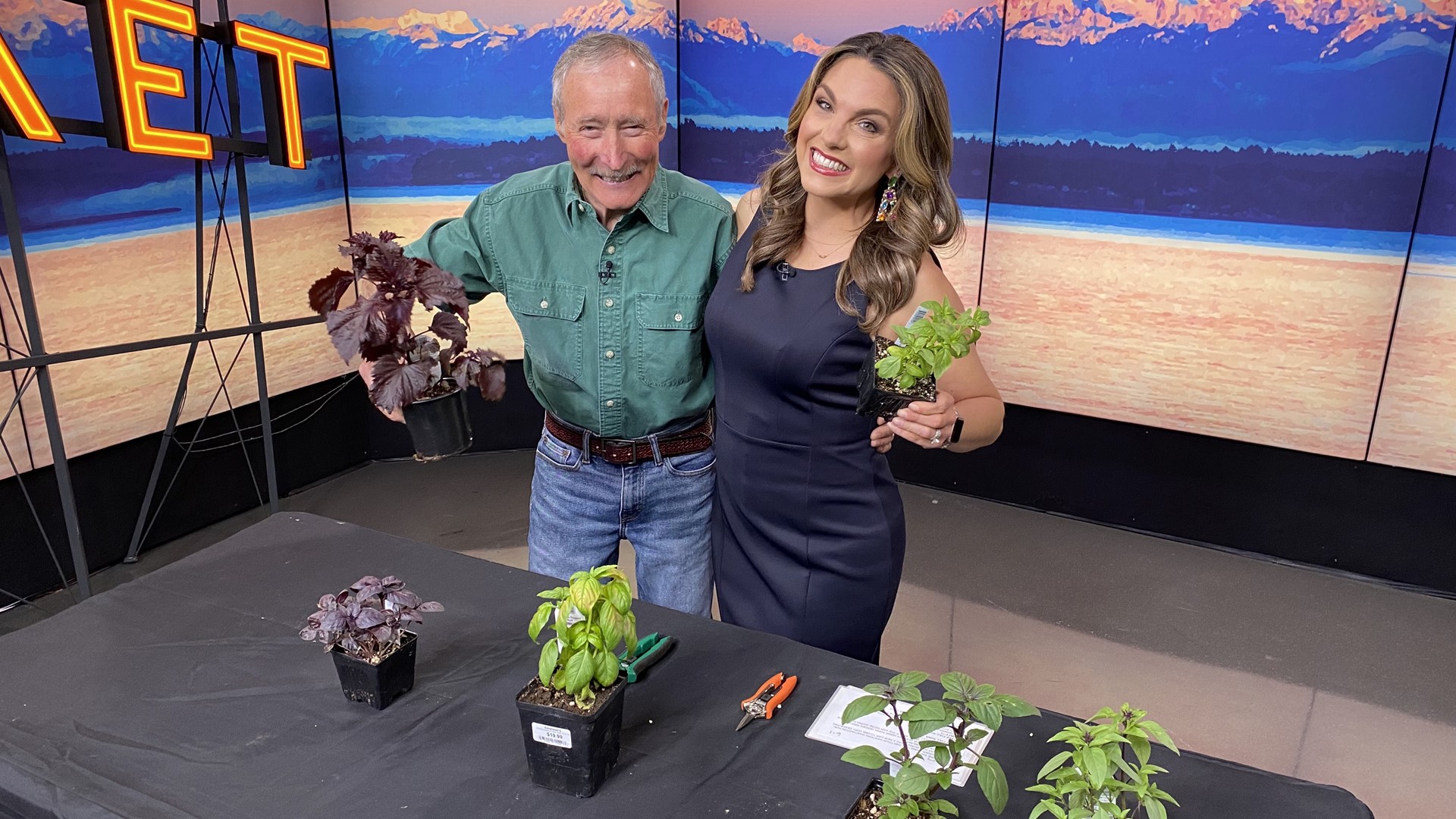SEATTLE — Ciscoe Morris joined New Day Northwest to talk all about basil. Here are some of his tips.
Associated with great taste, romance and fine dining, and a key ingredient in Italian, Indian and Asian cuisine, basil is one of the most popular herbs grown in PNW gardens.
It hasn’t, however, always been held in such high esteem. Renown 15th century French botanist Joseph Pitton de Tournefort wrote the following about basil: "A gentleman of Sienna was wont very frequently to dry the herb and snuff it up his nose, but he soon turn'd mad and died; and his head being opened by surgeons, there was found a nest of scorpions in his brain."
Oh, la, la! Just to be safe, maybe you shouldn’t ‘snuff’ it, but you can feel good about eating it. Basil is packed with disease-fighting antioxidants, high in vitamins and a good source of calcium.
Delicious as it is, basil is good for more than only cooking. There are over 60 different varieties and many have colorful leaves and interesting texture, making them great additions to container designs or a mixed border.
Here's a look at some of Ciscoe's favorites:
- My hands down favorite basil is Italian or Genovese basil. Genovese basil (Ocimum basilicum), with 2-3 inch long, dark green leaves, has a spicy, fragrant taste. It's the basil that you'll find at your grocery store and on top of your Margherita pizzas! It's often used in Italian dishes.
- For a blast of dark purple, it's hard to beat 'Amethyst Basil'. It's a Genovese basil that has thick, turned-down leaves with a similar shape to sweet basil. It is the only Genovese basil that is purple in color. This basil maintains its dark color all season and has an intense spicy flavor that adds zest to tomato sauce.
- The wavy leaves of 'Red Shiso’ are even darker in color. Shiso is an aromatic herb commonly used in Japanese cuisine. Known as “perilla leaf” in English, shiso is believed to have anti-bacterial properties.
- One of the most attractive and hardiest varieties of basil is also one of the most unique. The lavender-streaked foliage of 'African Blue' basil contrasts beautifully with pink blossoms on long purple stalks. This variety is also known for its somewhat overpowering, love-it-or-hate-it flavor that remains strong even after flowering occurs. You may not care to eat it, but you'll definitely want to grow it as an ornamental. The storehouse of its flavorful oils volatilizes on warm sunny days, releasing such a wonderful basil aroma that your garden will smell like the public market in Genoa.
- If you’re into making pesto, it’s hard to beat the spicy aroma and sweet clove-like taste of sweet basil. It looks great in a container design or a border as well. After all, bright green is a color too!
- Cinnamon basil, also known as Mexican spice basil, has a spicy, fragrant aroma and flavor. It contains methyl cinnamate, giving it a flavor reminiscent of cinnamon. Cinnamon basil has somewhat narrow, slightly serrated, dark green, shiny leaves with reddish-purple veins. Cinnamon basil is used in teas and baked goods such as cookies and pies. It is also used in pastas, salads, jellies, and vinegars. Outside the kitchen, cinnamon basil is used in dried arrangements and as a potpourri.
Tips for growing basil
The quickest way to murder basil is to plant it out in the garden too early in the season. Basil is a tender annual and quickly succumbs if night temperatures dip into the 40s. Fortunately, most local nurseries carry a great selection in pots ready to plant in June.
As long as you provide it with a hot, sunny location, and plenty of water, basil is among the easiest of herbs to grow. Steady, slow growth is the key to great taste, so amend the soil with compost and work only a quarter cup of an organic vegetable fertilizer under each plant.
Tips for harvesting basil
Basil contains the most oils when harvested before the flowers occur. Fortunately, the best way to delay flowering, as well as to encourage branching and new growth, is to harvest regularly by snipping off the end of the branches.
The best time to harvest is mid-morning; right after the dew has dried, but before the afternoon sun bakes the oils out. At some point later in summer, flowering will begin in earnest. Then it's time to harvest the entire crop, as flavor will go downhill soon afterward.
Tips for preserving basil
The best way to preserve basil is by freezing the leaves. An easy way is to blanch them in boiling water for 2 seconds, chop the leaves and fill ice-cube trays with them. Then cover with water and freeze.
You can also layer the blanched leaves between sheets of wax paper before freezing.
If you prefer to make pesto right away, the sauce can be frozen in ice cube trays. The frozen cubes can be stored in the freezer in plastic freezer bags for up to 6 months.
By the way, eating pesto while carrying on a conversation is an acquired skill. It’s incredibly difficult to speak with your hands without hitting the people sitting next to you at the dinner table!
Segment Producer Suzie Wiley. Watch New Day Northwest at 11 a.m. weekdays on KING 5 and streaming live on KING5.com. Contact New Day.

